SUMMARY OF FINDINGS
OVERVIEW
The 2006-07 Multi-Purpose Household Survey (MPHS) revealed that of the 7.4 million people aged 45 years and over who had, at some time, worked for two weeks or more, 4 million (54%) were in the labour force, 3.1 million (42%) had retired from the labour force, and the remaining 329,400 (4%) were not currently in the labour force but had not retired.
The likelihood of being retired increased with age. For those aged 45-49 years, just 6% were retired, compared to 23% of 55-59 year olds, 75% of 65-69 year olds and 95% of those aged 70 years and over.
Persons aged 45 years and over, Labour force and retirement status
- by age
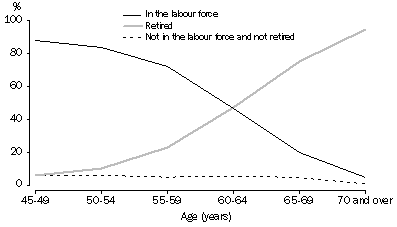
There were more men aged 45 years and over in the labour force than women of the same age. Conversely, there were more women who had retired than men, partly reflecting the fact that there are more women in the older age groups than men, and also reflecting the fact that women tend to retire earlier than men.
In 2006-07, 59% of men aged 45 years and over were in the labour force, 37% had retired, and 4% were not in the labour force but had not yet retired. In contrast, 48% of women aged 45 years and over were in the labour force, 47% had retired and the remaining 5% were not in the labour force but had not yet retired.
Persons aged 45 years and over, Labour force and retirement status
- by sex
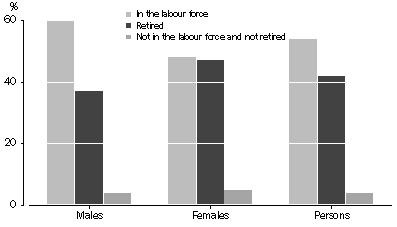
RETIRED FROM THE LABOUR FORCE
There were 3.1 million people aged 45 years and over who reported that they were retired from the labour force. This group comprised 1.4 million men and 1.7 million women. Half of all retired people were aged 70 years and over (53% of retired men and 48% of retired women were aged 70 years and over).
Age at retirement
It is important to note that data on retirement age presented in this publication only refer to 'surviving' retirees aged 45 years and over in 2006-07. Therefore, the distribution of retirement age in this population is not representative of the age at which all people retire. For example, based on Australian life expectancy, a person who retired aged 40 years in 1981-82 (aged 65 years in 2006-07) would more likely be alive to participate in this survey than a person who retired aged 65 years in 1981-82 (aged 90 years in 2006-07). This effect will be more pronounced for estimates presented in relation to people who retired a long time ago, but will have some affect on all estimates, particularly as 34% of the retired population included in this publication retired more than 20 years ago.
The average age at retirement from the labour force for people aged 45 years and over in 2006-07 was 52 years (58 years for men and 48 years for women). Of the 1.4 million men who had retired from the labour force:
- 53% had retired aged 55-64 years;
- 27% had retired aged less than 55 years; and
- 20% had retired aged 65 years and over.
The 1.7 million women who had retired from the labour force had retired on average at a younger age than men. The ages at which already retired women had retired from the labour force were as follows:
- 58% had retired aged less than 55 years;
- 35% had retired aged 55-64 years; and
- 7% had retired aged 65 years and over.
Persons retired from the Labour Force, Age at retirement (years)
- by sex
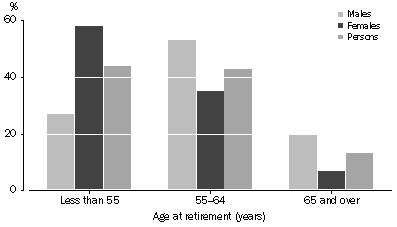
The average age at retirement for recent retirees (those who have retired in the last five years) was 60.3 years. Within this group, the difference between the retirement age of men and women was relatively small, with women retiring a little younger than men (the average retirement ages for this group were 61.5 years for men and 59.0 years for women).
Reasons for ceasing last job
Of the 2 million retired people who had worked in the last 20 years, 96% had held a full-time job at some stage. For just over three-quarters (76%) of those who held a full-time job, their last job held prior to retirement was full time. The remainder worked part time before retiring.
Among both retired men and women whose last job was less than 20 years ago, the most commonly reported main reason for ceasing their last job was 'reached retirement age/eligible for superannuation/pension' (42% of men and 28% of women). These people had one of the highest average retirement ages of 62 years, (63 years for men and 61 years for women). Other commonly reported main reasons given by people for ceasing their last job were 'own sickness, injury or disability' (29% of men and 19% of women) and 'retrenched/ dismissed/no work available' (10% of men and 9% of women).
Persons aged 45 years and over who have retired from the labour force, Selected main reason for ceasing last job
- by sex
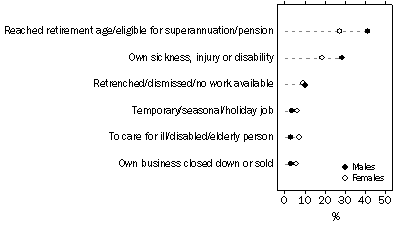
Sources of income during retirement
The main source of income at retirement varied quite markedly between men and women. For men, the most commonly reported main source of income at retirement was a 'Government pension or allowance' (52%), followed by 'superannuation or annuity' (22%). In contrast, almost half (47%) of women at retirement relied on their partner's income as their main source of income, followed by a 'Government pension or allowance' (33%) and 'superannuation or annuity' (7%).
Persons aged 45 years and over who have retired from the labour force, Selected main source of income at retirement
- by sex
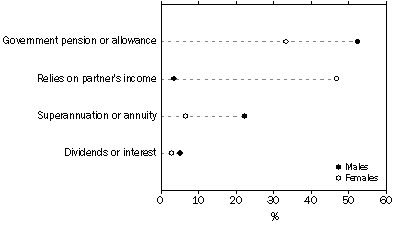
For many people, their main source of income during retirement changed from that at the beginning of retirement with more people becoming reliant on a 'Government pension or allowance'. While just under 1.3 million (42%) of those aged 45 years and over who had retired reported that a 'Government pension or allowance' was their main source of income at retirement, two million (66% of all those who were retired) indicated that this was now their main source of current income. This represents an increase of 57% compared with the number of people who stated that it was their main source of income at retirement. The next most commonly reported main sources of current income were 'superannuation or annuity' (14%) and 'dividends or interest' (8%).
Persons aged 45 years and over who have retired from the labour force, Selected main source of current income
- by sex
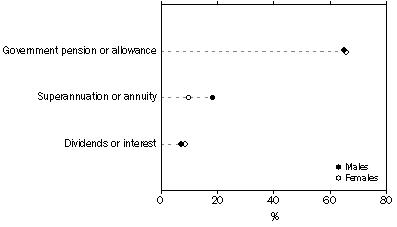
More than half of those whose main source of income at retirement was 'superannuation or annuities', 'dividends or interest' or 'rental property income' continued to rely on them as their main source of current income (67%, 61% and 55% respectively).
Superannuation scheme membership
Of the 3.1 million people aged 45 years or over who were retired from the labour force, 1.6 million (52%) had made contributions to a superannuation scheme. Men were more likely to have made contributions to a superannuation scheme than women. More than two-thirds (67%) of retired men aged 45 years and over had contributed compared to 41% of women. Of those who had made contributions, 63% had received all or part of their superannuation funds as a lump sum payment (64% of men and 61% of women). Many of those who received a lump sum payment used it to pay off or improve their existing home or purchase a new home (36% of men and 31% of women), to buy or pay off a motor vehicle (17% of men and 11% of women), or clear other outstanding debts (12% of men and 13% of women). Some reinvested their lump sum payment into an approved deposit fund, deferred annuity or other superannuation scheme (22% of men and 14% of women), or a bank account, personal savings or other investment (26% of men and 18% of women).
Of the 1.6 million retired people aged 45 years and over who had contributed to a superannuation scheme, men were more likely to have contributed for a longer period of time than women. Just over half of the men in this group (51%) had contributed for 20 years or more, compared to 22% of women in the same group.
PREVIOUSLY RETIRED
There were 281,100 people aged 45 years and over who had previously retired from the labour force but at the time of the survey were either in the labour force or were planning to look for, or take up, work in the future. Most of this group were women (192,500), and most of these women were in the labour force at the time of survey (160,400).
The most commonly reported reasons for returning to the labour force were 'financial need' (43%), 'bored/needed something to do' (33%), followed by 'interesting opportunity came up' (15%).
INTENTIONS TO RETIRE FROM THE LABOUR FORCE
Of the 4 million people in the labour force aged 45 years and over, 3.2 million (80%) indicated that they intend to retire from the labour force in the future. Of the remaining 791,100 people:
- 398,000 did not know whether they intend to retire from the labour force;
- 379,300 never intend to retire from the labour force; and
- 14,000 were unemployed and had never worked.
More than two-thirds (71%) of employed people who intended to retire worked full-time. About 41% of these intended to retire from full-time work and then work part-time before retiring from the labour force. Almost one-third (32%) intended to continue with full-time work until retiring from the labour force. The remainder did not know whether they intended to take up part-time work before retirement.
Age intends to retire
Of the 3.2 million people in the labour force who indicated that they intend to retire from the labour force, 1.3 million people (or 40%) did not know the age at which they would retire (36% of men and 44% of women). Of those who did indicate an age:
- 11% intend to retire aged 70 years and over (14% of men and 7% of women);
- 38% intend to retire aged 65-69 years (44% of men and 30% of women);
- 33% intend to retire aged 60-64 years (29% of men and 38% of women);
- 16% intend to retire aged 55-59 years (2% of men and 21% of women);and
- 2% intend to retire aged 45-54 years (0.7% of men and 4% of women).
The average age at which people intended to retire was 63 years (64 years for men and 62 years for women).
Factors influencing decision about when to retire
For those in the labour force who intend to retire, the most common factors influencing their decision about when they would retire were 'financial security' (44% of men and 41% of women), 'personal health or physical abilities' (40% of men, 40% of women), and 'reaching the eligible age for an old age (or service) pension' (12% of men and 11% of women).
Persons aged 45 years and over who intend to retire from the labour force, Selected factors influencing decision about when to retire
- by sex
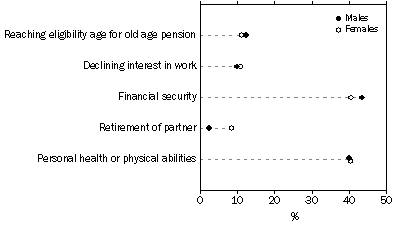
Main expected source of income at retirement
Just under half (49%) of the 3.2 million people aged 45 years and over who indicated that they intend to retire from the labour force reported their main expected source of income at retirement as 'superannuation or annuity'. More than half of men who intended to retire reported this (57%) as did 39% of women. The prevalence of 'superannuation or annuity' as the main expected source of income at retirement is consistent with the increase in the number of people participating in superannuation schemes. Over 93% of people intending to retire indicated that they had contributed to a superannuation scheme at some time, compared with 52% of people who had already retired.
The second most commonly reported main expected source of income was a 'Government pension or allowance' (22%), and this was reported by 20% of men intending to retire and 24% of women. It is interesting to note that 12% of people aged 45 years and over who intended to retire did not know what their main expected source of income at retirement would be - this was reported by 9% of men and 14% of women. 'Will rely on partner's income' was reported as the main expected source of income at retirement by 13% of women but by less than 1% of men.
Persons aged 45 years and over who intend to retire from the labour force, Selected main expected source of income at retirement
- by sex
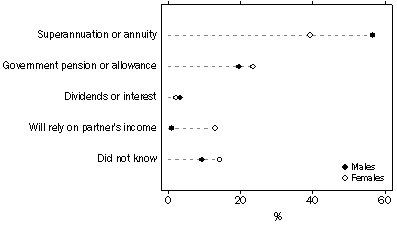
There were some notable differences reported by those who had already retired compared to those who intended to retire regarding their main (expected) source of income at retirement. While 42% of people aged 45 years and over who had already retired reported a 'Government pension or allowance' as their main source of income at retirement, only 22% of people aged 45 years and over who were intending to retire indicated that this would be their main expected source of income at retirement. 'Partner's income' was reported as the main source of income at retirement by 28% of those already retired but this was expected to be the main source of income at retirement for only 6% of people who intended to retire. Similarly, while 'superannuation or annuity' was reported as their main source of income at retirement by just 14% of those already retired, almost half of those who intended to retire (49%) expected that this would be their main source of income at retirement.
 Print Page
Print Page
 Print All
Print All
 Quality Declaration
Quality Declaration